Is the Sicilian town of Taormina the friendliest tourist destination in Italy? Yolanda Zappaterra spends a long weekend there to find out…
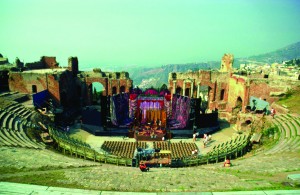 ‘La sposa arriva, la sposa arriva!’ shouts a small suited child excitedly as the hubbub from the crowd around the Chiesa San Giuseppe rises noticeably and hands begin to dig into bags of rice in readiness for the emergence of a newly married bride and groom. On Corso Umberto, hardly anyone bats an eyelid – though when a small remote-controlled helicam rises up above the crowd to get aerial shots of the event, a few eyebrows are raised. For the locals, it’s just another day in Taormina, where almost every day between May and September an endless parade of brides and grooms tread the Corso, accompanied by an entourage of photographers, videomakers, stylists and assorted snappily dressed friends and wellwishers. Why so many, and why here, I wonder as I nervously track the helicam hovering over my head? Anna, who I get chatting to in the Piazza IX Aprile, home to the sweet rococo church the happy couple have just vacated, believes it’s partly because the town is the prettiest in northeast Sicily, and she’s probably right. For despite being chockablock during the summer, when hordes of daytrippers, holidaymakers and cruise-ship tourists swell the usual residential numbers from 8,000 to 200,000, Taormina remains an utterly charming town, one that has been attracting tourists since the 18th century. Anna’s other claim – that the brides and grooms flock here because the residents of Taormina are unfailingly welcoming, polite, kind and unjaded – is something that, as a worldwise traveller, I’m cynical of and keen to test out – albeit as an everyday tourist rather than a bride.
‘La sposa arriva, la sposa arriva!’ shouts a small suited child excitedly as the hubbub from the crowd around the Chiesa San Giuseppe rises noticeably and hands begin to dig into bags of rice in readiness for the emergence of a newly married bride and groom. On Corso Umberto, hardly anyone bats an eyelid – though when a small remote-controlled helicam rises up above the crowd to get aerial shots of the event, a few eyebrows are raised. For the locals, it’s just another day in Taormina, where almost every day between May and September an endless parade of brides and grooms tread the Corso, accompanied by an entourage of photographers, videomakers, stylists and assorted snappily dressed friends and wellwishers. Why so many, and why here, I wonder as I nervously track the helicam hovering over my head? Anna, who I get chatting to in the Piazza IX Aprile, home to the sweet rococo church the happy couple have just vacated, believes it’s partly because the town is the prettiest in northeast Sicily, and she’s probably right. For despite being chockablock during the summer, when hordes of daytrippers, holidaymakers and cruise-ship tourists swell the usual residential numbers from 8,000 to 200,000, Taormina remains an utterly charming town, one that has been attracting tourists since the 18th century. Anna’s other claim – that the brides and grooms flock here because the residents of Taormina are unfailingly welcoming, polite, kind and unjaded – is something that, as a worldwise traveller, I’m cynical of and keen to test out – albeit as an everyday tourist rather than a bride.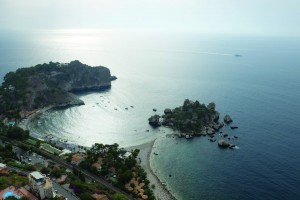
And so I set off to spend a weekend as a typical tourist in Taormina. This isn’t hard, for in a town where everything radiates off a swish central main artery, the kilometre-long Corso Umberto, almost every activity is a tourist one. Shopping for something as mundane as coffee filters at a picturesque salumeria mid-Corso, the proprietor wraps my purchase with as much care as he would a piece of precious jewellery, explaining that, as most of his customers are tourists buying gifts, he treats each purchase as though it were a gift. Nearby, at La Torinese sweetshop, the sales assistant offers us numerous nibbles as we deliberate over the gorgeous selection of nougats, biscuits and pastries on offer. Even in the high-end designer shops that make up much of the Corso’s retail offer, the staff are far more laid back and approachable than their counterparts in Paris or London would be.
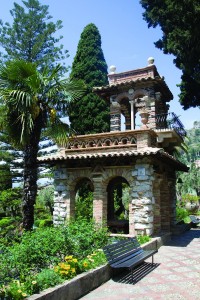
At the other end of the Corso, just outside the Catania gate, the personable Nina at C&G Cioccolato e Gelato patiently describes the contents of each type of chocolate on sale in a super-modern, pristine white space where colour is provided only by the eye-popping elaborate celebration cakes on sale – including, of course, vertiginous wedding ones. And nearby, at that most touristy of spots, the Gelateria O’Sciality, every ice-cream we ask about is proffered to us on a tiny neon plastic spoon to sample. It’s the same in the numerous bars and restaurants all over town: friendly staff and proprietors engage tourists in chat and banter as though they have all the time in the world. Roberto, the owner of Laboratorio Pasticceria Roberto and arguably the baker of the best cannoli in town, even insists we take photos with him and come back to meet to his son the next morning, and promises to put aside some cannoli for us to pick up when we get back from the beach, ‘because, signora, my cannoli sell out fast’. And indeed, when we come back, the vitrines are empty, but Roberto fills our reserved cannoli with mouth-watering sweetened ricotta filling before dipping them into the crunchy pistachio nut and brittle mix that define these local specialities.
What quickly becomes clear is that everywhere in Taormina where sales are the bottom line, people seem less bothered about making those sales than keeping tourists happy, but of course they know that happy tourists will nearly always translate into happy – and repeat – customers; we hadn’t planned to buy meringues when we popped into Pasticceria Mangia e Vinci, but when the baker urged us to sample some of the glistening and wonderfully chewy chocolate meringues he’d just taken out of the oven, we couldn’t resist. Combined with tiny wild strawberries from the market, they made a perfect Eton Mess as dessert for that evening’s meal. It’s a winning way of interacting with visitors.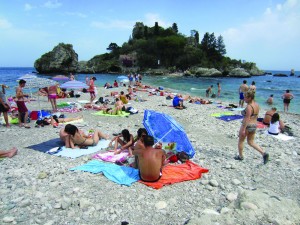
Less charming – or patient – are the staff at Taormina’s more traditional tourist sites. At the Teatro Greco, the surly ticketseller refuses to give my 79-year-old mother-in-law a discounted older person’s ticket despite our showing him proof of our EU status, simply because she doesn’t have some form of ID on her. Luckily, the arresting beauty of the attraction quickly help us forget him. The Teatro Greco is often cited as one of Sicily’s most magnificent and important sites, second only to Syracuse, and it warrants it. It’s still used for music and theatre performances throughout the summer (recent shows have included the operas Tosca and Cavalleria Rusticana, and concerts by James Blunt and Simple Minds) and each June hosts a week-long film festival – Italy’s oldest – which over its 60 years has attracted numerous Hollywood A-listers including, this year, John Turturro, Claudia Cardinale, Melanie Griffith and Carmen Maura. They’re drawn, one suspects, not so much by the status of the low-key festival as by the chance of a few days in this lovely area. For beyond the charms of the town itself there are some excellent attractions.
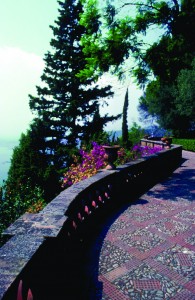 Walkers of most levels of fitness will enjoy the five-kilometre hike up to the hilltop town of Castelmola, where expansive views of the coastline can, on a clear day, stretch as far as Syracuse almost 100 miles away. If you’re feeling lazy, you can always opt instead for the shorter hike to the top of Monte Tauro. We decide to do this one before breakfast and clamber gamely like mountain goats past the pretty Santuario Madonna della Rocca to the remains of a Saracen castle above it. Here we stop for some amazing views up and down the coast, including our first look at one of its local stars, Isola Bella. This tiny rocky islet, joined by an isthmus to the coast immediately below the bluff on which Taormina sits, is largely occupied by a house and grounds that in the late 19th century were created by Isola Bella’s owner, the Englishwoman and conservationist Florence Trevelyan. For more than two decades Florence lived on the island, turning it into a haven for unusual and rare flora and fauna, much of which can still be seen if you pay €4 to enter the private areas of the island and the house, now a small museum. Having crossed the isthmus in bikini and flipflops, I don’t have €4 so decide to save this treat for a return visit. Instead, I splash about in the crystal clear water of the cove in which Isola Bella sits before gingerly making my way over the large rocks to eschew the Funivia cable car from the nearby beaches of Mazzarò in favour of a vertiginous climb up some 500 steps to the town above me, stopping often to draw breath and catch glimpses of gently smoking Etna, 50 miles away.
Walkers of most levels of fitness will enjoy the five-kilometre hike up to the hilltop town of Castelmola, where expansive views of the coastline can, on a clear day, stretch as far as Syracuse almost 100 miles away. If you’re feeling lazy, you can always opt instead for the shorter hike to the top of Monte Tauro. We decide to do this one before breakfast and clamber gamely like mountain goats past the pretty Santuario Madonna della Rocca to the remains of a Saracen castle above it. Here we stop for some amazing views up and down the coast, including our first look at one of its local stars, Isola Bella. This tiny rocky islet, joined by an isthmus to the coast immediately below the bluff on which Taormina sits, is largely occupied by a house and grounds that in the late 19th century were created by Isola Bella’s owner, the Englishwoman and conservationist Florence Trevelyan. For more than two decades Florence lived on the island, turning it into a haven for unusual and rare flora and fauna, much of which can still be seen if you pay €4 to enter the private areas of the island and the house, now a small museum. Having crossed the isthmus in bikini and flipflops, I don’t have €4 so decide to save this treat for a return visit. Instead, I splash about in the crystal clear water of the cove in which Isola Bella sits before gingerly making my way over the large rocks to eschew the Funivia cable car from the nearby beaches of Mazzarò in favour of a vertiginous climb up some 500 steps to the town above me, stopping often to draw breath and catch glimpses of gently smoking Etna, 50 miles away. 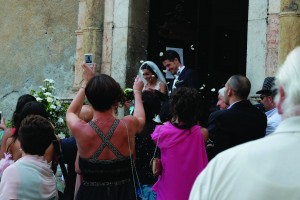
It’s probably Etna that first drew tourists here in the 18th century, but when Goethe discovered the nearby town and sang its praises in his Italian Journey, it became an integral part of the Grand Tour, drawing the likes of Guy de Maupassant, Alexander Dumas, Johannes Brahms, Gustav Klimt, Richard Wagner, Oscar Wilde, and DH Lawrence, who lived in the town for three years and wrote much of Lady Chatterley’s Lover here. What this all means for the 21st century tourist is amazing hotels, great food, and charming hospitality. Maybe Anna’s right. Maybe, more than anything else, it is old-school good manners that make Taormina such a draw for wedding parties.
For where to eat and where to stay, as well as top places to see, click here!
